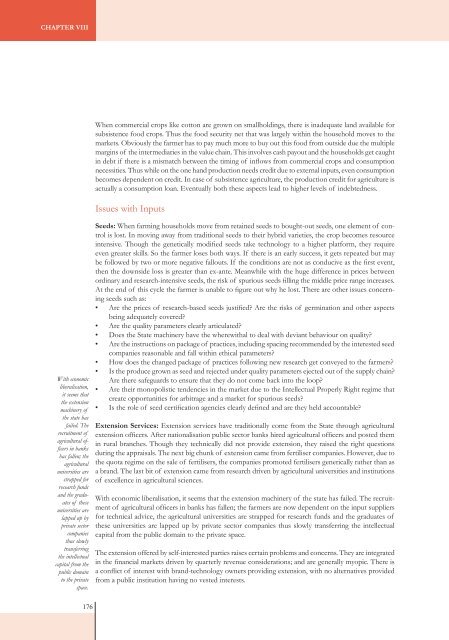SOIL Report 2008 - ACCESS Development Services
SOIL Report 2008 - ACCESS Development Services
SOIL Report 2008 - ACCESS Development Services
Create successful ePaper yourself
Turn your PDF publications into a flip-book with our unique Google optimized e-Paper software.
Chapter VIIIWhen commercial crops like cotton are grown on smallholdings, there is inadequate land available forsubsistence food crops. Thus the food security net that was largely within the household moves to themarkets. Obviously the farmer has to pay much more to buy out this food from outside due the multiplemargins of the intermediaries in the value chain. This involves cash payout and the households get caughtin debt if there is a mismatch between the timing of inflows from commercial crops and consumptionnecessities. Thus while on the one hand production needs credit due to external inputs, even consumptionbecomes dependent on credit. In case of subsistence agriculture, the production credit for agriculture isactually a consumption loan. Eventually both these aspects lead to higher levels of indebtedness.Issues with InputsWith economicliberalisation,it seems thatthe extensionmachinery ofthe state hasfailed. Therecruitment ofagricultural officersin bankshas fallen; theagriculturaluniversities arestrapped forresearch fundsand the graduatesof theseuniversities arelapped up byprivate sectorcompaniesthus slowlytransferringthe intellectualcapital from thepublic domainto the privatespace.Seeds: When farming households move from retained seeds to bought-out seeds, one element of controlis lost. In moving away from traditional seeds to their hybrid varieties, the crop becomes resourceintensive. Though the genetically modified seeds take technology to a higher platform, they requireeven greater skills. So the farmer loses both ways. If there is an early success, it gets repeated but maybe followed by two or more negative fallouts. If the conditions are not as conducive as the first event,then the downside loss is greater than ex-ante. Meanwhile with the huge difference in prices betweenordinary and research-intensive seeds, the risk of spurious seeds filling the middle price range increases.At the end of this cycle the farmer is unable to figure out why he lost. There are other issues concerningseeds such as:• Are the prices of research-based seeds justified? Are the risks of germination and other aspectsbeing adequately covered?• Are the quality parameters clearly articulated?• Does the State machinery have the wherewithal to deal with deviant behaviour on quality?• Are the instructions on package of practices, including spacing recommended by the interested seedcompanies reasonable and fall within ethical parameters?• How does the changed package of practices following new research get conveyed to the farmers?• Is the produce grown as seed and rejected under quality parameters ejected out of the supply chain?Are there safeguards to ensure that they do not come back into the loop?• Are their monopolistic tendencies in the market due to the Intellectual Properly Right regime thatcreate opportunities for arbitrage and a market for spurious seeds?• Is the role of seed certification agencies clearly defined and are they held accountable?Extension <strong>Services</strong>: Extension services have traditionally come from the State through agriculturalextension officers. After nationalisation public sector banks hired agricultural officers and posted themin rural branches. Though they technically did not provide extension, they raised the right questionsduring the appraisals. The next big chunk of extension came from fertiliser companies. However, due tothe quota regime on the sale of fertilisers, the companies promoted fertilisers generically rather than asa brand. The last bit of extension came from research driven by agricultural universities and institutionsof excellence in agricultural sciences.With economic liberalisation, it seems that the extension machinery of the state has failed. The recruitmentof agricultural officers in banks has fallen; the farmers are now dependent on the input suppliersfor technical advice, the agricultural universities are strapped for research funds and the graduates ofthese universities are lapped up by private sector companies thus slowly transferring the intellectualcapital from the public domain to the private space.The extension offered by self-interested parties raises certain problems and concerns. They are integratedin the financial markets driven by quarterly revenue considerations; and are generally myopic. There isa conflict of interest with brand-technology owners providing extension, with no alternatives providedfrom a public institution having no vested interests.176














